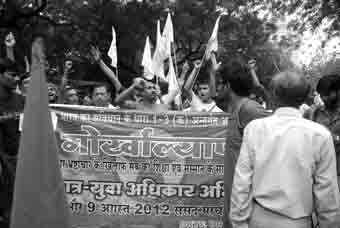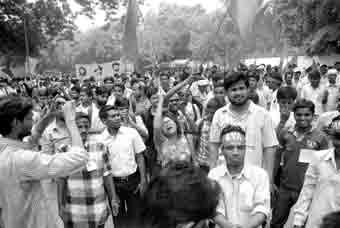 The battle lines became clear. Young people from all over India who marched to Parliament on 9 August, the anniversary of the Quit India movement, declaring ‘corporate plunderers Quit India’, and demanding equitable education and dignified employment as fundamental rights, found that the barricades at Parliament Street were manned the Sashastra Seema Bal (central Armed Border Force) in large numbers! What can be clearer proof that for the UPA Government, the country’s younger generation and democratic protestors have become an ‘enemy’ force?
The battle lines became clear. Young people from all over India who marched to Parliament on 9 August, the anniversary of the Quit India movement, declaring ‘corporate plunderers Quit India’, and demanding equitable education and dignified employment as fundamental rights, found that the barricades at Parliament Street were manned the Sashastra Seema Bal (central Armed Border Force) in large numbers! What can be clearer proof that for the UPA Government, the country’s younger generation and democratic protestors have become an ‘enemy’ force? Faced with the ominous sight of the SSB contingent in full gear, the students and youth did not baulk. They marched forward and stormed the barricades – and braved a brutal beating by the police and SSB.

Before marching to Parliament, the huge gathering of students and youth, under the banner of AISA and RYA, held a massive meeting, which blockaded the Jantar Mantar road. Waving red flags, and colourful painted hoardings and banners, they raised slogans of ‘Corporate Plunderers Quit India’ and ‘Shame on UPA Government that Subsidises Corporates and Sells Out Students’.
The mass meeting was addressed by national leaders of the AISA and RYA, and the main speaker was CPI(ML) General Secretary Dipankar Bhattacharya. He said that the battle against corruption not be waged by the likes of Baba Ramdev who hobnobbed with communal killers and made deals with ruling class parties, and who ran away when the police attacked. He also said that Anna Hazare too had failed to target corporate plunder as the root of corruption. He congratulated the students and youth for taking corporate plunder head on – by barricading Parliament Street last year, and now by storming the barricades.

After a rousing call by leaders of the AISA and RYA leaders, the students and youth began marching peacefully towards Parliament. This march to parliament was participated by AISA and RYA leaders and activists from 19 states, including Tamil Nadu, Karnataka, Andhra Pradesh, Assam, Karbi Anglong, West Bengal, Darjeeling, Punjab, Maharashtra, UP, Uttarakhand, Bihar, Jharkhand, Gujarat, Madhya Pradesh and Delhi. The student and youth wings of the Communist Party of Revolutionary Marxists (CPRM), DRSF and DRYF, also joined the March to Parliament. The March broke down the first two barricades, braving a severe lathicharge by police and Sashastra Seema Bal in which more than 50 students suffered severe injuries.

Several AISA and RYA activists from Delhi, UP, and Andhra Pradesh sustained head injuries and a comrade from Madhya Pradesh fractured his leg in the lathi charge. The police also detained AISA and RYA’s national leadership and some activists for a short while but had to release them soon under pressure from thousands of students and youth who refused to walk away from the barricades at Jantar Mantar.
The march to Parliament was led by AISA President Sandeep Singh and General Secretary Ravi Rai, RYA President Mohd. Salim and General Secretary Kamlesh, DRYF leaders Sekhar Chhetri, Rabin Rai, and Arun Ghatani, DRSF leaders Birendra Giri and S Chamling, JNUSU President Sucheta De, RYA leaders Amarjit Kushwaha, Bal Mukund Dhuria, AISA leaders Abhyuday, Malay, Bharati, Diganta, and other AISA and RYA leaders of several states.

What issues were the young protestors raising? Last year, AISA and RYA had barricaded Parliament for 100 hours, targeting corporate plunder and pro-corporate policies as the root of corruption, and demanding an effective Jan Lokpal Bill. The March to Parliament this year took forward that campaign, highlighting the linkages between corporate plunder and scams, and the rights of students and youth to equitable education and employment.
Youth in particular are feeling let-down by the growing crisis of employment and education. According Census 2010 data, more than 50% of India’s population is under 25 years; and 70% of the population is under 35 years. This makes India home to the world’s largest youth population. The Government often seeks to justify disastrous pro-corporate policies – be it land acquisition, FDI in retail, or opening up of crucial sectors of the economy for corporate control – by claiming that they would promote ‘growth’, create jobs for Indian youth, and expand educational opportunities. Facts, however, show that corporate-led ‘growth’ has proved to be an all-out offensive on the rights and potential of young Indians.

Young India vs Corporate Corruption
The UPA Govt claims ‘fund crunch’ for education; and argues for privatised, corporatized education.
But here are some startling facts:
The education budget in 9 Years of UPA Rule = Rs 3.52 lakh cr
UPA’s 2 Mega Scams (2G Scam + Coal Scam) = Rs 3.56 lakh cr
Revenues Foregone by UPA As Tax Waivers etc for Corporates EVERY YEAR: Rs 5 lakh cr
Corporate loot in just two UPA-sponsored scams equalled what UPA Govt. spent in 9 years on education!
And every year, as ‘Revenues Foregone,’ the UPA gifts corporates more than its total 9-Year Budget for education!
Young India’s Fate:
Ill-paid, Insecure, Undignified Jobs
Let us consider the period of 2005-2010: five years which saw some of the worst scams. This was also the worst offensive of neoliberal policies (privatisation, pro-corporate policies). What was the state of jobs during this period?
• During 2004-05 to 2009-2010, employment elasticity (percentage change in employment with respect to percentage change in GDP) was almost zero (0.02).

• While GDP increasing at a 9% rate, employment grew at a negligible rate of just 0.22%.
• In agriculture, on which almost 60% of the population continues to be dependant, the employment rate was minus 1.60%.
• The youth unemployed in India make up almost half (49%) of the total unemployed despite the fact that, the youth share of the total adult workers is only 21%.
So, the glorious period of ‘9% growth rate’ was a period of JOBLESS GROWTH.
‘Growth’ meant a licence to loot for India’s corporations, while, for India’s young people, it meant desperate unemployment.
What kind of jobs were, in fact, created?
• A dangerous casualisation of the workforce: Between 2004-05 and 2009-10, the number of casual workers grew by 21.9 million, while growth in the number of regular workers nearly halved (compared with the period between 1999-2000 and 2004-05) to 5.8 million
• 50% of the youth workers are ‘self employed’ – i.e in insecure jobs like street vendors etc
• 35% of youth workers are casual labourers
• 26% of youth employed suffer from poverty (around 22 million).
• Around 40% of youth population are categorised as ‘vulnerable’.
Even in the organized, manufacturing sector (covered in ASI), we find shrinking share of wages, rising share of profit:
• Rise in labour productivity was 5 fold between 1980s-2010
• However the Wage Bill declined from 30% of net value-added in 1980s, to 11.6% by 2009-10
• Educated youth – such as the Maruti workers – are employed on contract, overworked, underpaid, and threatened with loss of job if they try to organise for better wages and conditions, while corporate employers openly violate labour laws
In industry, too, corporates rule – while the youth are enslaved.
Robbing the Right to Equitable Education
The recent case in Bangalore where a private school shaved hair of the little kids enrolled under the RTE’s mandatory 25% quota for poor students, and the incident in Chennai where a little girl from a working class family, fell to her death through the floor of a private school bus show that merely reserving seats for the poor in schools dominated by the rich can only mock at the idea of ‘right to education.’ Private schools continue to charge high fees while failing to provide basic quality and safety, and humiliating children from weaker economic and social backgrounds.
The path is being paved for unfettered corporate plunder in higher education. The proposed new bills in the education sector (the Foreign University Bill, Innovation Universities Bill, Private Universities Bill, and the Educational Tribunal Bill for instance) all seek to give private, corporate, and foreign players a licence to exploit the so-called ‘education market’, while enjoying immunity from the laws of the land. These corporate and foreign players
• Will not be bound to provide social justice,
• Will be allowed to charge unregulated fees,
• Will be virtually exempt from quality control
• And will enjoy legal immunity too, since clause 47 of the Education Tribunal Bill debars every student from approaching court against injustices done by private institutions